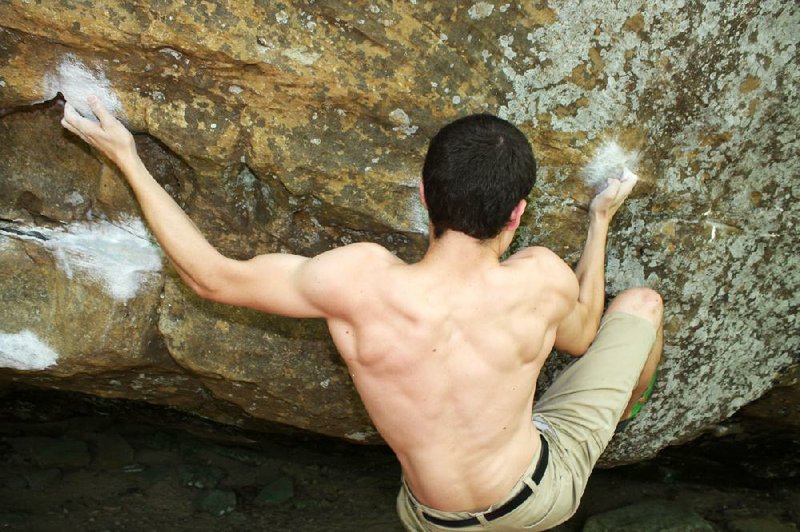NEWTON COUNTY — Editor’s note: Once again writer Bobby Ampezzan will spend his summer tackling a new-to-him and overwhelmingly difficult fitness activity. This time it’s bouldering.
Here is the first in a series of every-other-week reports.
There are dozens of “bouldering problems” along a stand of tall, exposed dolomite caps and cliffs at a well-set rock climbing area generally referred to by the name of the town directly south, Cowell.
I use quotation marks as alternative asterisks, place holders, really, for an explanation herewith:
“Bouldering” is a spinoff of rock climbing. It’s the most challenging movements in rock climbing, without ascent. Extreme rock climbing without ropes because it never exceeds more than about 20 feet.
In bouldering, “problems” is a synonym for abbreviated routes or “fun” challenges.
The way I just used “fun,” I was being sarcastic.
On Tuesday, Patrick Small, 19, and Miriam Daniel, 21, left Little Rock for a day trip to three savory spots called Fountain Red, Fred’s Cave and Power Wall.
Daniel obsessed over a pudgy 10-foot problem named “Give It to Mikey” - bouldering names are gossamer - inside a dim corridor between converging boulders at Fountain Red. She made a couple of dozen runs at the problem before giving up, disgusted.
“You made progress, and that counts. That’s the definition of bouldering: You do the same thing over and over again and expect a better outcome,” said Small, consolingly. “Which happens to also be the definition of insanity.”
BOULDERING LEAGUE
As it has for four years now, the Little Rock Climbing Center organizes an eight-week summer Boulder League. Two-dozen or more members pay an additional$10 for weekly bouldering competitions, scored individually and by team. Some of these climbers are advanced, but some, like me, when given the prompt “Today I climbed ...,” would finish it “... out of bed.”
In past years winners have been compensated with some token financial award, but Logan Wilcoxson, owner operator of the climbing center, said the real reward is meeting new potential climbing partners.
Daniel and Small met at the climbing center (though not in Boulder League). Now, they get together regularly.
Daniel says rock climbing relates to indoor climbing much the way running corresponds to running on a treadmill. But “the concentration of the climbing community in Little Rock is there at the center, so you kind of find people who want to get outside, do the same kinds of things you want to do, and you can kind of work together.”
Hanging with Daniel and Small on Tuesday, I understood what she means. Bouldering is an immersive experience. At its sharpest, it focuses the body’s pentasensory inputs on gripping the shallowest contours of a flat plane with the tips of your toes and tracking the thinnest ridges with finger pads, but most of the time it isn’t that acute. It’s a broader experience - the smell of moldering tree trunks, the chatter of oak leaves excited by the wind.
Notwithstanding, the act of climbing a boulder or its gym analog stimulates in any of us one of our earliest thrills. We learn to climb before we can walk. Before we muster the coordination and muscle to balance ourselves on our two feet, we use our hands and legs in four-point positions to maneuver stairs and other obstacles. The instinct to discover what’s on top of, around or over predates our physiological abilities to get there by foot.
Of course, at this late age, the rewards aren’t cognitive but experiential. We know what’s at the top of the stairs and inside the kitchen cupboards. We put it there. No, we climb for the experience. The question isn’t what’s there, but can we get there.
“You have to create a reality of doing it for yourself,” Small says. “If you create a reality of doing it, you can do it. If you don’t create a reality of doing it, maybe you’ll do it, maybe you won’t do it.”
ActiveStyle, Pages 23 on 06/25/2012

